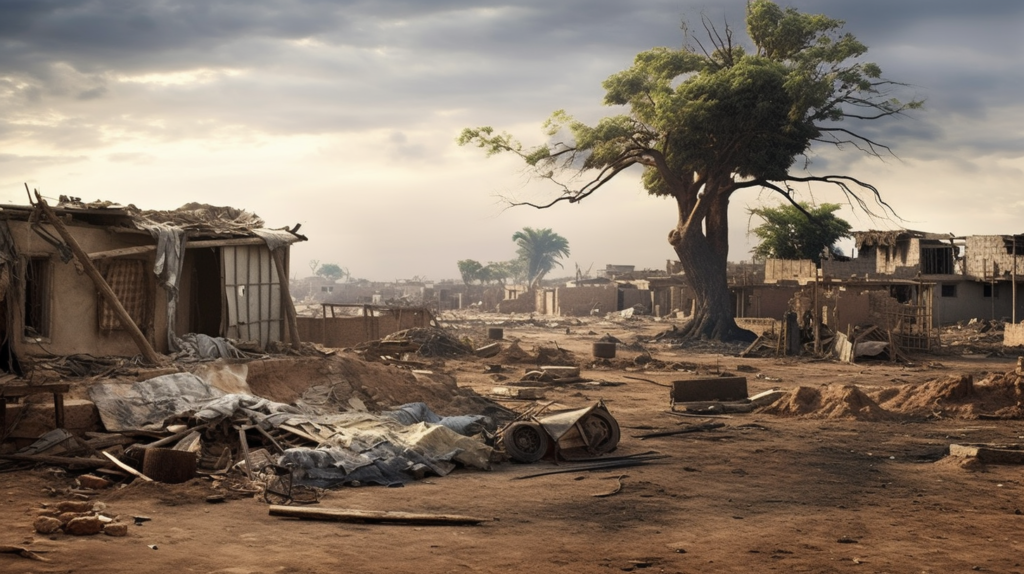
Darkness
Out of darkness
From the sprawling settlement of a refugee camp in Nigeria, a remarkable narrative unfurls. It is here that Amina, a resilient woman uprooted from her native village by unforgiving conflict, confronts a formidable adversary – the obsidian cloak of night. As part of my research, I found myself immersed in this stirring account, urged by a persistent, humanistic drive to comprehend, expound, and hopefully, alleviate the quandaries of people affected by humanitarian crises. The dark gloom of nightfall breeds anxiety in the camp. As the daylight wanes, women and girls face a challenging ordeal, one often overlooked by those unfamiliar with such hardship. Amina must cross a yawning expanse of unlit terrain to reach an outhouse, a journey fraught with perceived and tangible perils – sanitation issues, potential animal or insect presence, and an unsettling fear of gender-based violence. Amina says, “We don’t feel comfortable at all using the toilet if the lock is broken and if no lighting.” A dark outhouse, she confides, turns an act of basic necessity into an unwanted adventure of its own. Another resident echoes Amina’s sentiment, remarking, “There is no way I feel comfortable to go that far a distance to change menstrual pads at night.” The stark reality of these accounts underlines the urgent need for a resolution.
This research, born from a Focus Group Discussion in Northeast Nigeria, is a mission molded directly from the heart of this community. In this pursuit of enlightenment, I, as an explorer, am merely the conduit, broadcasting their stories and their solutions to the world. The aim? To transcend the boundaries of conventional problem-solving and give the power back to those affected. Indeed, as night descends over the camp, it appears as if the entire expanse is swallowed by a ravenous shadow. The camp’s rudimentary lighting fails to hold back the advancing darkness, rendering the journey to the outhouse perilous and disorienting. In the face of this adversity, Amina’s courage illuminates the obsidian landscape. But it is our responsibility to translate her bravery into action, a meaningful response to her predicament. This research, thus, demands not just empathy but innovation – an urgent call for safer, more dignified solutions.
The system is a unique integration of solar-powered lighting and alerting mechanism designed for outhouses in refugee camps, with an emphasis on community involvement and education. The heart of the system is a 3D printed control panel housing a low-wattage LED bulb, an SOS button, a brightness control dial, and a tamper-proof lock. The LED bulb is powered by a solar panel mounted on the roof of the outhouse. The bulb emits sufficient light to illuminate the outhouse, and the brightness can be controlled through the panel. The solar panel, linked to a rechargeable battery, ensures uninterrupted power supply, even during the night or on cloudy days. An SOS button on the panel, when pressed, triggers an external light to flash bright red and turns on an audible siren. This system is designed to alert the camp members in case of an emergency. The 3D printed panel also integrates a simple, robust, tamper-proof locking mechanism to ensure privacy and security for the users.
The cost-effectiveness of the solution is one of its key attributes. Preliminary costs were documented as follows:
- Solar Panel & Battery: $8
- LED bulb, external alert light, and siren: $4
- 3D printed control panel: $3
- Locking mechanism: $2
- Miscellaneous (wiring, connectors, etc.): $1
This brings the total capital cost per cubicle to under $20, fitting the maximum budget outlined. The solution capitalizes on the abundant solar energy, making it renewable and sustainable. The LED bulb consumes minimal power, and the solar panel size can be optimized for the power requirements. The 3D printed panel offers flexibility in design, durability, and low manufacturing cost. The SOS alerting system, with its visual and audio signals, ensures swift communication in case of emergencies.
The installation in an outhouse involves fixing the solar panel on the roof, connecting it to the rechargeable battery and the control panel inside the outhouse. Users can easily adjust the brightness of the LED bulb using the control panel. In case of distress, users can press the SOS button, which will trigger the external alert system. The locking mechanism provides privacy and security to the users. Community engagement and education form a crucial part of the solution. The installation process will involve local community members, with experts providing them hands-on training. Regular maintenance workshops will ensure that community members can troubleshoot minor issues and perform routine maintenance. This system will also serve as a learning tool for young residents, getting their interest in renewable energy and technology, potentially inspiring future careers in the STEM fields.
This was only phase 1 of the research project. During this phase, we engaged the younger generation and asked for their input in the creative development process. This can positively teach principles of engineering, electrical engineering, and innovative, leading principles of technology. During phase 2, the intent is to engage the community to develop the best possible solution off of the above design matrix. This will then move it forward into final implementation.
